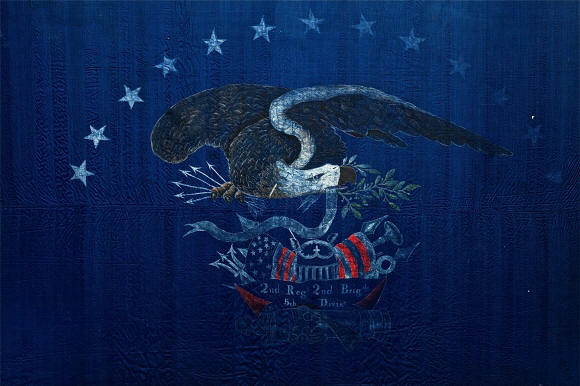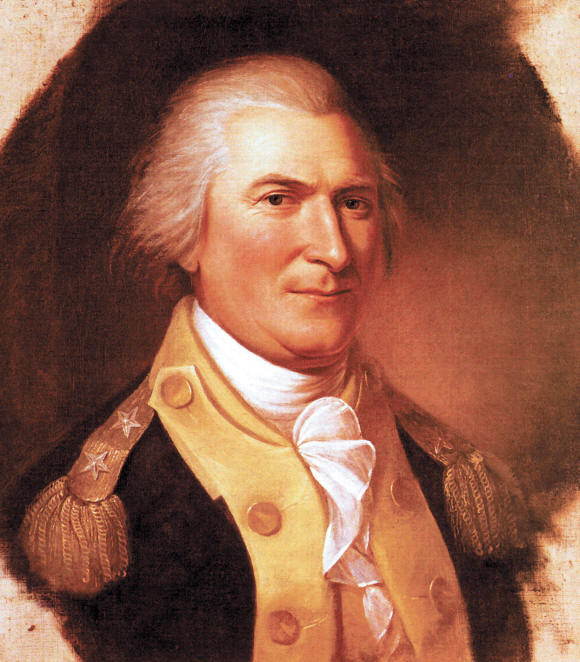Submitted in Partial Fulfillment of the Requirements for the Degree of MASTER OF ARTS IN HISTORY IN THE GRADUATE SCHOOL OF THE UNIVERSITY OF ILLINOIS.
Major General Arthur St. Clair - A Brief Sketch

This flag represents the earliest known
surviving flag of the United States Army to date. This flag was
identified at auction as an 1830’s NY State Miltia Flag. Leading flag
scholars assert this flag was made for an unidentified unit from
1812-1830’s! In this document, it can be proven that the flag was made
by
Robert Scot, the US Great Seal maker for Gen. Arthur St. Clair.
You can download this document here
The St Clair Papers
The Life and Public
Service of Arthur St. Clair
Soldier of the Revolutionary War, President of the Continental Congress;
and Governor of the North Western Territory
With the Correspondence and Other Papers arranged and annotated by
William Henry Smith (1882)
Volume I |
Volume II

Thanks so much for your time and suggestions today.
Arthur St. Clair was a man that never seemed to receive any credit or public
attention for his achievements, but was often "scapegoated" for the mistakes
of others. As a result, historians have avoided him because to them, the
embattled general must have appeared to have been "damaged goods."
Some history professors often sum up his life with this phrase, "he was an
unfortunate victim of circumstances who deserved better." After six years of
research I found that to be a great understatement and set out to tell his
untold story. In fact , the book is really a collection of untold stories
about Arthur St. Clair's 40-year military and public service career. More
info is enclosed as well as visuals
St. Clair was of enormous help to George Washington, especially in the area
of strategic military planning which was not his strongest point in the
early years of the Revolutionary War. The cover of the book was designed to
suggest the two in a before-battle session.
Regards.
Dick Phillips

Sometimes there’s a story behind a story which might be inconvenient truths
for, or expose the agendas of, those in charge. Often the public never hears
those back stories, mostly for political reasons. The effects of these
falsely reported stories can be disastrous to the reputation of the person
involved.
But for 240 years?
Such occurrences happened often during the formation and development of
America, when Congress was micro-managing every military aspect of the war.
During his 40-year military and public service to America, Arthur St. Clair
survived three such actions by Congress and although his career grew
steadily, his deserved reputation as a brilliant strategist and courageous
military leader did not. And yet this patriot, who became a Major General, a
Congressman, President of Congress and Federal Governor of the Northwest
Territory, has generally been ignored by historians for centuries.
St. Clair walked with the giants of the American Revolution, Franklin,
Washington, Hamilton, Jefferson, Green, Lafayette, Adams and others.
It was Washington who recruited him as one of the early Scottish Freemasons
in America. Many St. Clair/Sinclair descendants even say that Ben Franklin
inducted him. Perhaps one reason why historians haven’t written about this
courageous Scot is because he thought and acted outside the box. He always
tried to do what was right, regardless of the consequences. This often put
him in the crosshairs of the powers that be and he paid a heavy price.
“It’s one thing to help your commander restore his reputation, like St.
Clair did for Washington in the last days of 1776-77. Although he expected
no credit then, it was quite another to be made a scapegoat for military
mistakes of Congress and others One doesn’t easily recover from that,” says
author, R.W. Dick Phillips, who recently released the book entitled, ARTHUR
ST. CLAIR, THE INVISIBLE PATRIOT, which is available on Amazon.com, Barnes
and Noble and other book stores.
At 328-pages and 24 chapters, the book deals with this native Scot becoming
a British officer to fight the French in Canada’s Seven Years War. After
retiring and settling in western Pennsylvania, he spent most of the next
decade helping the Scottish settlers fight off Indian attacks and worked in
various judicial capacities assigned by Governor Penn. After he learned that
the Indian raids had been incited by the British command in Virginia, he
became increasingly critical of the British taxation and their brutal
treatment of Colonists and their families.
Accepting a commission as Colonel in the Continental Army. his recruiting
talent, strategic planning and leadership experience quickly became known
and he found himself promoted to Brigadier General and assigned to
Washington’s senior staff within a year. But the war was not going well and
Washington had lost most of his men during 1776 and was suffering trust
issues with his Major Generals Charles Lee and Horatio Gates. When his most
experienced Major General Mercer died in the battle of Princeton, Washington
saw St. Clair, the man that had helped him turn around an all-but-lost
revolutionary war with three victories in New Jersey, as his next Major
General. The two were trusted fellow combatants and remained friends during
the first 20 years of the Republic
This book details the stories behind several incorrectly-reported stories of
St. Clair’s life. The author describes the book as both biographical and an
historical commentary, reflecting his extensive research. A retired PR
agency exec., the Phillips’ moved to the Ohio Valley to be closer to their
family and he became interested in its rich history.
“After some newspaper and magazine articles about early pioneers began
appearing, my fellow Rotarians suggested I look at Arthur St. Clair, the
namesake of our city, St. Clairsville, Ohio,” said Phillips, adding, I
didn’t expect to take on a retirement project of this magnitude, but after
researching the Library of Congress and about 70 other sources, I was
hooked. St. Clair’s story needed to be told!”
Reach R. W. Dick Phillips on Facebook (also under book title). See reader
reviews on Amazon.com, also available on Walmart.com, Barnes and Noble and
various museum Book Stores, such as Rosslyn Chapel in Midlothian, Scotland
Arthur St. Clair, The Invisible Patriot
You can purchase this book on Amazon.com

